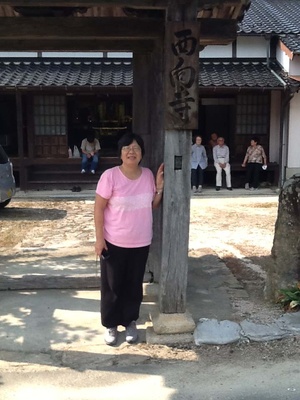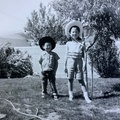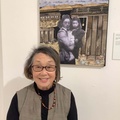I had not expected to ever touch the temple entrance gate from the 1939 photo of my great-grandfather and his family. But here I was in Yamaguchi, Japan, reverently stroking and leaning against the weathered wood pillars and admiring the “Saikoji” sign. I was visiting my son, Kenzo, who did a study abroad semester during his junior year.
This journey began nearly forty years ago, when I was a young woman in my twenties. I was intrigued by an old black and white photo of my great-grandfather, Nobuyuki Oda and his family. They were posing near the family temple, Saikoji Temple in Yamaguchi, Japan. Many years later, I became determined to locate the temple.
“Where is this temple?” I asked my mom and all her brothers and sisters. By that time, my grandparents had passed away. No one seemed to know the address of the temple or any living relatives to contact. I tried internet searches, but this proved frustrating. It turned out that Yamaguchi had hundreds of small family temples!
Finally, I contacted a friend in Japan who directly contacted the Yamaguchi temple headquarters. Through the kanji characters that my uncle had written for “Saikoji”, my friend was able to confirm the address of the temple. I wrote a letter to the temple in English and had my Buddhist minister translate it into Japanese. I enclosed a copy of the 1939 photo of my great-grandfather and another photo of what appeared to be the fujinkai or women's group. With high hopes, I mailed the letter to Japan.
Months passed and I almost gave up hope of hearing from the temple. Then in December, I received a letter from Saikoji Temple. It had photos of the temple and its members. I was so excited to see the photos, but the letter was written in Japanese. I couldn’t wait until Sunday service to get translation, so I emailed a photo of the letter to my friend in Japan. He quickly sent back a translation.
However, there was another disappointment. The temple no longer had a resident minister. That meant there were no surviving family members. Instead, a group of temple supporters took care of the temple and chanted several times a year with the visiting minister. The kind man who had written the letter was Mr. Miyata, representing the temple supporters.
I wrote another letter in English, which my minister again translated into Japanese. I also sent more photos. I was able to correspond this way with Mr. Miyata. I didn't think I'd get a chance to visit Japan any time soon. But then in the spring of 2016, my son, Kenzo, left for Japan.
Finally, summer arrived! I was in Japan!! I met Kenzo in Sendai, in northern Japan, on a hot, humid afternoon. Two days later we flew to Fukuoka in southern Japan. We took a train to Kumamoto to meet relatives for a weekend. Then we boarded a train to Yamaguchi, about an hour away. Mr. Miyata, a thin man with slightly graying hair and a kind face met us at the train station. He wore a light blue short-sleeved shirt and beamed with happiness at our arrival.
About ten of the temple supporters, all seniors, met us at the temple on that sweltering day in July. There were more women than men. They had bento lunches, snacks, and cold drinks waiting for us. I presented them with the omiyage (gift) for the temple.
Mr. Miyata’s wife had a sunny disposition which matched her cheerful yellow top. There was a tiny elderly woman with white hair. A gray-haired woman with an outgoing personality asked many questions. A cheerful man with glasses and a colorful shirt was inquisitive. There was laughter and shared camaraderie.
The temple supporters especially liked Kenzo, as he was the only young person present. They wanted to know what he was studying in California, where he had traveled in Japan, and what he wanted to do in the future. I told the group that I was a teacher in Los Angeles and had been searching for the temple for many years. Thanks to three years of Japanese classes at U.C. Berkeley and several months in Japan, Kenzo was able to translate their questions and also our answers.
The Saikoji Temple was small, but had a very beautiful gold altar. The wooden floor was covered with mats. Exterior sliding doors were open, letting in some air. There were wooden memorial plaques displaying the names Oda Nobuyuki (great-grandfather) and also Oda, Hakuai (grandfather). There was a small modern kitchen and bathroom at one side of the temple. At one time my great-grandfather and his family had lived there. Now a visiting minister came a few times a year for chanting.
Even though the original temple gate was there, the temple itself had been badly damaged by a typhoon many years ago and had undergone major renovation. There was a black and white photo of the opening of the new temple building. One of the women pointed out the much younger image of herself in the photo.
Of course, we took a group photo. Kenzo and I sat in a place of honor and the temple members sat around us. Afterwards, we took a tour of the outside of the temple. We saw a small garden and the weathered gate that looked the same as in the 1939 photo. I thought of my great-grandfather and his family and wondered if their hands had touched the gate in the same places that mine had. I wondered about their lives. What were their happy or sad moments, hardships or challenges, enjoyments?
While I felt sad that there were no family members to meet, I was grateful to the temple supporters for all the years they had taken care of the Saikoji temple. Many of the supporters gave us little gifts. Kenzo and I did a lot of bowing as we thanked everyone.
Then we climbed into Mr. Miyata’s car and waved goodbye to everybody. We rode past the green rice fields next to the temple and onto the modern highway.
© 2018 Edna Horiuchi








